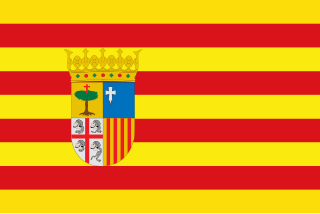
Aragon is an autonomous community in Spain, coextensive with the medieval Kingdom of Aragon. In northeastern Spain, the Aragonese autonomous community comprises three provinces : Huesca, Zaragoza, and Teruel. Its capital is Zaragoza. The current Statute of Autonomy declares Aragon a historic nationality of Spain.

Ejea de los Caballeros, commonly known simply as Ejea, is a town and municipality in the province of Zaragoza, part of the autonomous community of Aragon, Spain. It is one of the five main towns in the Comarca de las Cinco Villas, along with Sos del Rey Católico, Uncastillo, Sádaba, and Tauste.

Biota is a municipality of Spain belonging to the province of Zaragoza, autonomous community of Aragon. The town is part of the Cinco Villas Region and it is located on the banks of the Arba de Luesia River. It has an area of 128.8 km2 with a population of 912 inhabitants.
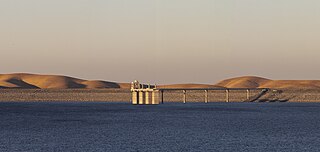
San Luis Dam, also known as B.F. Sisk Dam, is a major earth-filled dam in Merced County, California, which forms San Luis Reservoir, the largest off-stream reservoir in the United States. The dam and reservoir are located in the Diablo Range to the east of Pacheco Pass and about 10 miles (16 km) west of Los Banos. San Luis Dam, a jointly-owned state and federal facility, stores more than 2 million acre feet (2.5 km3) of water for the California State Water Project and the federal Central Valley Project. Although the dam is located in the valley of San Luis Creek, the majority of its water comes from man-made aqueducts which are supplied from other rivers in Northern California.
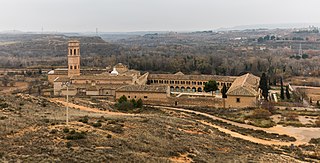
Rueda Abbey or Rueda de Ebro Abbey is a former Cistercian monastery in Sástago in the Ribera Baja del Ebro comarca, province of Zaragoza, Aragon, Spain, 74 kilometres to the south-east of Zaragoza on the left bank of the Ebro. The buildings have been preserved by the government and are intended to be used for a hotel and conference centre.

The Bardenas Reales is a semi-desert natural region, or badlands, of some 42,000 hectares in southeast Navarre (Spain). The soils are made up of clay, chalk, and sandstone and have been eroded by water and wind creating surprising shapes, canyons, plateaus, tabular structures, and isolated hills, called cabezos. Bardenas Reales lacks urban areas, vegetation is scarce and the many streams that cross the territory have a markedly seasonal flow, staying dry most of the year.
The Central Utah Project is a US federal water project that was authorized for construction under the Colorado River Storage Project Act of April 11, 1956, as a participating project. In general, the Central Utah Project develops a portion of Utah's share of the yield of the Colorado River, as set out in the Colorado River Compact of 1922.

Perunchani Dam is an irrigation dam at Perunchani, Kanyakumari District, in the state of Tamil Nadu, India. It is one of the dams of the Kodayar Irrigation System. As there was water deficiency in the Kodayar Irrigation System, Perunchani Dam was constructed in December 1952 to store flood water of the Paralayar River as an extension. It was built about 1 km (0.62 mi) upstream of the Puthen dam on the Paralayar River. The irrigation system became operational on 2 September 1953. It feeds the left bank irrigation canal system of the Puthen dam, which is the terminal structure of the system.

Scofield Reservoir is a 2,815-acre (11.39 km2) reservoir impounded by Scofield Dam, in Carbon County, Utah. Located on the Price River, a tributary of the Green River, Scofield Reservoir is adjacent to the northernmost boundary of the Manti–La Sal National Forest. The reservoir sits at an elevation of 7,618 feet (2,322 m), on the northern edge of the Wasatch Plateau. Utah State Route 96 runs along the western shoreline.
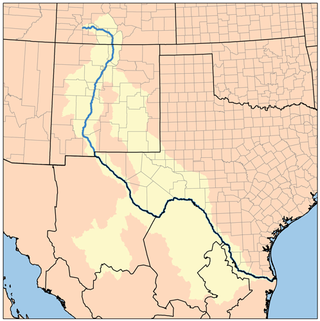
The Rio Grande Project is a United States Bureau of Reclamation irrigation, hydroelectricity, flood control, and interbasin water transfer project serving the upper Rio Grande basin in the southwestern United States. The project irrigates 193,000 acres (780 km2) along the river in the states of New Mexico and Texas. Approximately 60 percent of this land is in New Mexico. Some water is also allotted to Mexico to irrigate some 25,000 acres (100 km2) on the south side of the river. The project was authorized in 1905, but its final features were not implemented until the early 1950s.
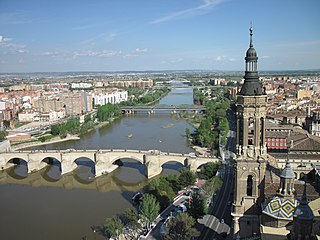
The Ebro is a river of the north and northeast of the Iberian Peninsula, in Spain. It rises in Cantabria and flows 930 kilometres (580 mi), almost entirely in an east-southeast direction. It flows into the Mediterranean Sea, forming a delta in the Terres de l'Ebre region, in southern Catalonia. In the Iberian peninsula, it ranks second in length after the Tagus and second in discharge volume, and drainage basin, after the Douro. It is the longest river entirely within Spain; the other two mentioned flow into Portugal. It is also the second-longest river in the Mediterranean basin, after the Nile.

The Muel Dam was a Roman gravity dam in Zaragoza province, Aragon, Spain, dating to the 1st century AD.

The Yesa Reservoir is located in the Pyrenees, and is formed with the damming of the Aragon River, in the Navarre town of Yesa (Spain), although the largest area of the reservoir is located in the province of Zaragoza, extending from east to west. It is located to the northwest of the Aragonese province of Zaragoza and to the east of Navarre. Most of it floods lands of the Berdun Canal, in the Aragonese region of Jacetania in the municipalities of Sigüés, Ruesta, Escó, and Tiermas. It is known by the nickname Mar de los Pirineos and is located at the entrance of the aforementioned. It is the largest navigable area of Aragon and it is the source of the Bardenas Canal that transfers water to the Ribera area south of Navarra and irrigates the Bardenas Reales and the Cinco Villas region of Zaragoza. It is also used for water supply and as a power station.

The Imperial Canal of Aragon is a 110-kilometre (68 mi) zanja and navigation canal built from 1776 to 1790 between Fontellas (Navarre) and Fuentes de Ebro (Aragón). Its construction was intended to improve the irrigation of the old Acequia Imperial de Aragón, bringing water from the Ebro River to Zaragoza and allowing the irrigation system to be extended in the region. It also established a passenger and freight transport service between Tudela and Zaragoza.

The Sierra de Leyre or Sierra de Leire is a mountain range in Navarre (Spain). It is the first pre-Pyrenean mountain range and is located in the northeast of the Comunidad Foral. It is 30 km long and has an east–west orientation.

Ruesta is a former settlement in the province of Zaragoza, in the autonomous community of Aragon (Spain), today belonging to the municipality of Urriés, in the region of Cinco Villas, judicial district of Ejea de los Caballeros.
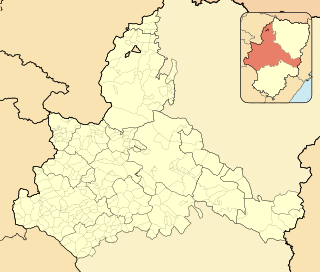
Bardenas, is a settlement in the municipality of Ejea de los Caballeros, in the province of Zaragoza.

Tiermas is an uninhabited settlement in the province of Zaragoza, in Aragon (Spain), belonging to the municipality of Sigüés in the comarca de Jacetania. It is on the banks of the Aragón river next to the Yesa Reservoir that partly floods it.

The Ebro Hydrographic Confederation is the organization that manages, regulates and maintains the water and irrigation of the Ebro hydrographic basin. The organization's headquarters are in Zaragoza and it was the first institution created in the world with the objective of managing an entire river basin in a unitary manner.
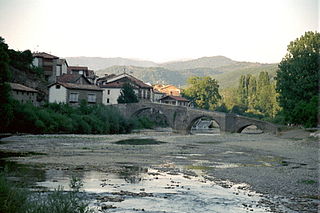
The Ezka river is a tributary of the Aragon river that flows along 51 kilometers, mainly through the region of Navarra and to a lesser extent through Aragon. It rises at the junction of the Belagua and Uztárroz rivers in the Navarre town of Isaba and flows south through the valley to its mouth at the Yesa Reservoir, downstream from the Aragonese town of Sigüés.
























